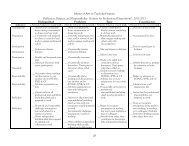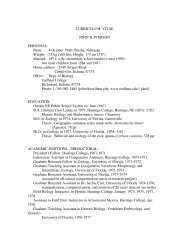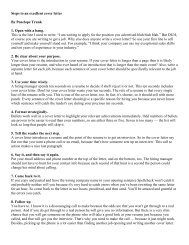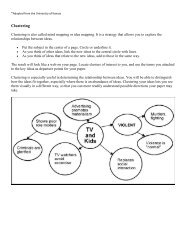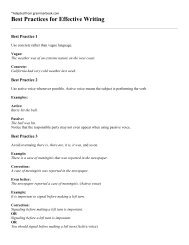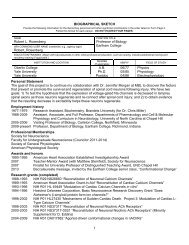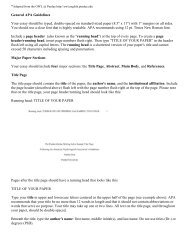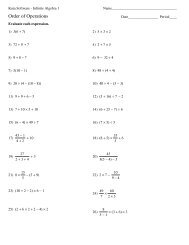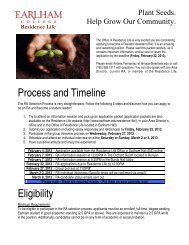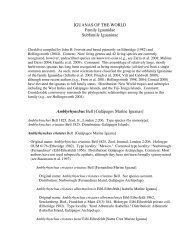PDF download - Earlham College
PDF download - Earlham College
PDF download - Earlham College
You also want an ePaper? Increase the reach of your titles
YUMPU automatically turns print PDFs into web optimized ePapers that Google loves.
Running head: GOLDEN RATIO IN PATTERN AND PAGE DESIGN<br />
Comparing the Golden Ratio in Context and Non-context Conditions:<br />
Using Page Design and Geometric Patterns<br />
Jean-Pierre Aramis Gary<br />
<strong>Earlham</strong> <strong>College</strong>
Comparing the golden ratio 1<br />
Abstract<br />
After reviewing the literature on the golden ratio, it was concluded that no study had<br />
conclusive evidence that the ratio was favored in comparison to others. Studies have<br />
only observed the golden ratio in abstract conditions. This study examined the golden<br />
ratio and other ratios (unity, thirds and a random ratio) in publishing design layouts,<br />
isolated rectangles, and simple patterns, with the hypothesis that there would be a shift of<br />
preference between ratios. A total of 68 college undergraduates scored on two scales<br />
(subjective and objective) the aesthetic appeal of four different ratios in shapes, patterns<br />
and designs. The experiment showed that participants favor the golden ratio, but in<br />
context situations only, such as advertisements and magazine articles (designs) rather<br />
than abstract patterns or shapes.
Comparing the golden ratio 2<br />
Comparing the Golden Ratio in Context and Non-context Conditions: Using Page Design<br />
and Geometric Patterns<br />
The golden ratio, also referred to as the golden section, or the Fibonacci ratio,<br />
among other names, refers to an irrational number. Like pi (3.141…) it cannot be<br />
expressed in a ratio of two whole numbers; in fact, it is mathematically the most irrational<br />
number (Livio, 2002). Simply put (and to the fifth decimal place) the golden mean is<br />
1.61803. Referred to also as phi, (in honor of the Greek architect Phidias, one of many<br />
architects who built the Parthenon) the frequency of occurrence and aesthetic appeal of<br />
the golden mean in nature has stumped philosophers, scientists, mathematicians, and<br />
artists (Konecni, 2003; Livio, 2002). Aestheticians argue it is the epitome of beauty,<br />
while astronomers have discovered its occurrence in the expression of thermodynamics in<br />
black holes (Livio, 2003). The golden ratio is also the most efficient proportion in<br />
phyllotaxis (leaf arrangement) in plants (Livio, 2002). In addition, the number has been<br />
manipulated by artists in hopes of making more gratifying masterpieces.<br />
Arguably 1.61803 is beautiful. The ratio has been used to create a grid that fits<br />
only beautiful faces accurately. Across cultures people rate faces that fit this golden ratio<br />
grid as more beautiful than those that do not (The Human Face, 2001). See Figure 1.<br />
Other studies have found similar results in comparing different body types. Bodies which<br />
are rated the most well-proportioned and pleasing are consistently found to be in golden<br />
ratio (Haseltine, 2002, Marquardt Beauty Analysis, 2003, The Human Face 2001).<br />
Additionally, what humans have distinguished as beautiful in nature for countless<br />
centuries, has been on occasion in connection with the golden section. For example, all<br />
nautilus shells grow in Fibonacci sequence (See Figure 2 and Figure 3). In the Fibonacci
Comparing the golden ratio 3<br />
sequence, each term in the sequence following the second number is equal to the sum of<br />
the two earlier numbers (i.e. 1,1,2,3,5,8…) (Livio, 2003). As the Fibonacci sequence<br />
progresses “the ratio of two successive Fibonacci numbers oscillates about (being<br />
alternately greater or smaller) becoming closer and closer to the Golden Ratio” (Livio,<br />
2002, p.101). The Fibonacci sequence can be used to create a spiral, which fits into a<br />
golden rectangle (See Figure 3). In the year 2000, Tucker discovered falcons following<br />
this logarithmic spiral when descending on prey, because it was the most wind resistant<br />
fashion of descent while keeping the prey in focus (Livio, 2003). Roses and sunflowers<br />
have arrangements of petals and seeds respectively that are in proportion to the golden<br />
ratio. Some researchers argue that the golden ratio can frequently be discovered in<br />
animals, plant and human life because it is genetically ingrained in the growth and<br />
development of organisms (Haseltine, 2002; The Human Face, 2001). It functions as a<br />
mathematical blueprint for genes to follow in how to develop an organism into a full<br />
grown adult. It is possible that because the golden ratio is genetically ingrained in<br />
organisms, this is why phi also functions not only as a very pleasing proportion but can<br />
be utilized as a very effective ratio in design for living organisms (Gielo-Perczak, 2001).<br />
Oddly enough the ratio also crops up in human behavior as well. In estimating positive<br />
to negative opinions and majority to minority preferences that people make on an issue,<br />
the golden ratio is relatively accurate in predicting positive and majority choices of a<br />
group statistically (Benjafield, 2000, Gross & Miller, 1997). In comparing positive to<br />
negative poles on an object (i.e. good or bad scores of a cartoon figure), participants<br />
scored positive poles 61.5% of the time (0.168 is the golden section) (Lee & Adams-<br />
Webber, 1987).
Comparing the golden ratio 4<br />
As stated, arguably 1.61803 is beautiful. Research findings have been<br />
contradictory and inconclusive on whether the golden ratio is preferred aesthetically over<br />
other ratios. In prior findings the golden line or the golden rectangle were used in<br />
comparison to the unity ratio (symmetrical divide: 1:1), the thirds ratio (1:2) and other<br />
ratios(Boselie, 1984; Davis & Jahnke, 1991; McManus, 1980; Russell, 2000). Additional<br />
studies compared preferences between artists and non-artistically educated individuals<br />
(Macrosson & Stewart, 1997). Some studies found a larger preference for the unity ratio<br />
(1:1) in geometric shapes such as the square over the golden ratio, whereas artists<br />
preferred the thirds ratio (Davis & Jahnke, 1991, Macrosson & Stewart, 1997). Livio has<br />
said “There is no conclusive scientific proof that the human mind reacts in any special<br />
way to shapes in the golden proportion” as noted in Chown (2002, p.55).<br />
It is reasonably logical that by itself the golden ratio has no shape appeal. It is<br />
said to function as a blueprint for living development. Removing it from such a context<br />
in essence voids any effectiveness it may have. In principle phi makes something more<br />
appealing by amplifying its beauty, therefore it serves no effective purpose as an abstract<br />
shape. The golden section by itself does not make beauty, or create an aesthetic<br />
preference. This does not refute the theory that the golden section has a strong aesthetic<br />
application; it just can not function abstractly or alone without context. Earlier studies<br />
have compared different ratios in abstract shapes and patterns to one another and found<br />
no preference for the golden ratio over other ratios in the participant’s choices (Davis &<br />
Jahnke; 1991, Macrosson & Stewart, 1997; McManus, 1980; Russell 2000). In fact<br />
participants scored some of the other ratios higher in preference. Russell went a step<br />
further, in making participants interact with the study, by asking them to make a rectangle
Comparing the golden ratio 5<br />
that they found to be the most pleasing . Results did not find any preference for the<br />
golden ratio. Russell (2000) found that none of his 189 participants in his abstract<br />
condition constructed a golden ratio. All of these studies did not put the golden section<br />
into context. The purpose in studying the golden section and other specific ratios using<br />
only geometric shapes is to remove all other confounding variables that could influence<br />
aesthetic preferences. Unfortunately, this also removes the context or the environment in<br />
which the golden ratio is effective. “An exclusive focus on context-free judgments is<br />
restrictive because, in everyday life, people usually do not make aesthetic judgments<br />
about isolated geometric shapes” (Russell, 2000, p.35).<br />
Macrosson and Stewart (1997) found it is relatively rare for participants to divide<br />
a line into golden ratio. Artists divided the lines on average into thirds. This is logical,<br />
as all artists are taught to never center their work, and to use the rule of thirds which<br />
forms a better balance. Earlier, Schiffman and Bobko (1978) found that when doing the<br />
same task, psychology students on average divided a line in half (Macrosson & Stewart,<br />
1997). There is, again, logic behind a random pool of participants (who, one assumes,<br />
are less artistically aware) dividing the line symmetrically. “The Gestalt Law of<br />
Pragnanz holds that percepts tend to the simplest, most regular, and symmetrical<br />
form…gestalt principles imply an aesthetic predisposition toward figures in the unity<br />
ratio…” (Davis & Jahnke, 1991, p.258).<br />
In general, prior research has supported a preference among participants for the<br />
unity ratio when are asked to divide or construct by aesthetic choice a rectangle (Davis &<br />
Jahnke, 1991). The golden ratio is not likely to be used consciously by a participant<br />
when making or dividing geometric shapes by aesthetic choice. Russell (2000) found
Comparing the golden ratio 6<br />
that of the 339 rectangles made in his overall study, only one rectangle was made in<br />
golden ratio. When using isolated lines and shapes, the fastest and easiest solution is to<br />
make a shape that is symmetrical, balanced, and geometrically pleasing. “People divide<br />
visual patterns perceptually along axes of symmetry… it is generally agreed that people<br />
process patterns by searching for regularities such as symmetry and repetition” (Boselie,<br />
1984, p.372). A symmetrical shape projects a sense of order, suggesting objective<br />
correctness and control (Boselie, 1984).<br />
Placing the golden section into context is where the appeal of the ratio has been<br />
discovered and is used in commonplace items. Russell (2000) touched on this in his<br />
second experiment, where he asked participants to produce a rectangle that would look<br />
the best for a painting, or kitchen tile. Results showed a tendency among participants to<br />
recreate the culturally accepted proportion commonly produced rather than actual<br />
preferences the participants may have. When it comes to actual conventional design,<br />
research has found that designs which give the best ease of use are designs which utilize<br />
the golden proportion within the ratios that are the most pertinent (Gielo-Perczak, 2001).<br />
Pertinent ratios in a conventional design, refer to the parts in the product and their<br />
respective proportions which are interactive and vital for functional use with the user.<br />
Irvine, Snook, and Sparshatt (1990) found the most satisfactory stairway design was<br />
using the golden section in ratio of riser to tread (Gielo-Perczak, 2001). Coincidently, the<br />
golden ratio can be found in the ratio of height to width of every credit card (5.4cm x<br />
8.5cm), and a standard sheet of paper when folded in half (13.97cm x 21.59cm) (Gielo-<br />
Perczak, 2001). Why do these designs operate well in society? Gyorgi Doczi studied US<br />
governmental survey data to show that the golden ratio can be found in all human
Comparing the golden ratio 7<br />
dimensions (Gielo-Perczak, 2001). If the ratio is frequent in human measurements,<br />
production of ergonomic design with the golden section is a likely way to make the two<br />
harmonize with one another. Such was found in kitchen knives. A knife that has a blade<br />
to handle proportion in golden ratio is more pleasing and is more efficient to use because<br />
the knife and the person are united by the same ratio (Gielo-Perczak, 2001).<br />
It is worth noting, that in one study, web design pages did not work effectively in<br />
golden ratio. Schaik and Ling (2003) found that on average using the golden section<br />
resulted in less speed, accuracy and display quality in comparison to other ratios used.<br />
They were more concerned with the functional aspects rather than the aesthetics of the<br />
golden section. The effectiveness of the golden ratio was limited by the context of the<br />
experiment. The webpage was displayed in a square window. The width of the window<br />
was divided with a vertical line forming two rectangles (the left frame and a main frame).<br />
Screen ratios were determined by percentages of the screen width in use by the<br />
navigation (left frame) and the content page (main frame). There was no actual golden<br />
rectangle or golden section shape visible to the participants in the study. The ratios of the<br />
two rectangles were not in golden ratio. The rectangles were in golden ratio by percent<br />
of screen width (38.2% to 61.8%).<br />
There are many difficulties when asking participants to judge geometric shapes or<br />
draw with the hope of finding evidence of preference for the golden ratio or any other<br />
ratio. Depending on how instructions are given, the participant may give a subjective or<br />
an objective response as found by Hekker, Peper, and Wieringen in 1994 (Russell, 2000).<br />
Subjective judgments by the participant are determined by term usage, such as likeability,<br />
pleasantness, and attractiveness. Objective responses result from term usage that may
Comparing the golden ratio 8<br />
include: quality, goodness, and balance (Russell, 2000). Participants with a college level<br />
art education had the tendency to objectify responses. Objective analysis involves more<br />
of a formal evaluation of the stimulus, whereas subjective analysis usually refers to an<br />
inner reflection and judgment by the participant. Subjective judgments focusing on the<br />
pleasantness of a rectangle tend to favor the golden ratio, whereas objective judgment<br />
scores favor the unity ratio in rectangles (Russell, 2000).<br />
The present study investigated the influence the golden ratio has on isolated<br />
figures, rectangular patterns, and page designs scales in comparison to other ratios, using<br />
subjective and objective scales. The researcher’s goal was to map out a progression of<br />
preferences among ratios from abstract geometrical form to page design. Page design’s<br />
fundamental base is the rectangle, which serves as an environmental framework to use<br />
the golden ratio in comparison to other proportions in the study. This is an effective<br />
medium for comparison of ratios because everything within the design will stay relatively<br />
constant but the ratio itself.<br />
The hypothesis is that the golden ratio preference among participants will become<br />
more apparent in more complex and context driven patterns. In the stimuli that are least<br />
context driven, the participants will show less of a preference for the golden ratio and<br />
more of a preference for the unity ratio and thirds. In designs which are less abstract, and<br />
which imitate those seen in the media, the participants will show a preference for those in<br />
golden ratio.
Comparing the golden ratio 9<br />
Method<br />
Participants<br />
A total of 68 undergraduate college students participated in the study; 14 marked<br />
the score sheet incorrectly, and therefore their results were not used in the statistical<br />
analysis. As a result, 54 responses from participants were used, of which 15 were men,<br />
and 39 were women. The age range was 18 to 25 years, and the mean age was 20 years.<br />
Those who signed up during psychology classes received extra credit for their<br />
participation. Others were recruited outside of psychology classes. Participants included<br />
psychology majors, art majors, and layout design editors from the campus newspaper,<br />
among others.<br />
Materials<br />
A total of four different proportions were used to devise 40 different stimuli each<br />
made to fit a blank piece of cardstock paper (20.32cm x 25.4cm). The four proportions<br />
were 1:1.618 (golden ratio), 1:1 (unity ratio), 1:2 (ratio of thirds), 1:1.3 (randomly chosen<br />
ratio by researcher). A random ratio was added in the experiment to compare levels of<br />
significance of the other more prominently known ratios to a randomly chosen one. The<br />
40 different stimuli were subdivided into 4 different categories (pattern groups) for<br />
testing degrees of context. The different stimuli were printed onto cardstock paper rather<br />
than displayed on a computer screen because the amount of detail to view each stimulus<br />
would not fit adequately on a computer screen or projector.<br />
The first question (and pattern group) consisted of a set of four stimuli each<br />
representing the four proportions in rectangles, centered on separate pages. This was the<br />
isolated figure group in the experiment. See Figure 4. The second pattern group utilized
Comparing the golden ratio 10<br />
the proportions to make an array of rectangles. For example using the ratio of thirds,<br />
rectangles would have a height of 1 and a length of 2 (1:2). There were three different<br />
patterns used among the four different proportions, resulting in 12 different stimuli in the<br />
second group. One of these patterns was a duplication of the article layout found in the<br />
fourth group, but in rectangular form. See Figure 5.<br />
The third pattern group used the proportions to make the rectangles but also made<br />
all the rectangles in each stimulus in proportion to one another. For example, when using<br />
the golden ratio, the rectangles would not only be in golden ratio (i.e. length of 1.618 by a<br />
height of 1), but a rectangle larger would be 1.618 times larger in size to a smaller<br />
rectangle. The third group consisted of 3 different patterns and 4 different proportions<br />
for each pattern with a total of 12 stimuli. See Figure 6.<br />
The final group, the most context-driven and least abstract, consisted of<br />
mimicking possible page designs. The four proportions were used to make three separate<br />
designs for a total of 12 stimuli in this category. The first page design was a Kodak<br />
advertisement. Four mock Kodak ads were made using each of the ratios. All the<br />
rectangles in the image were in ratio to their respective proportions. The next page<br />
design was a mock Gatorade ad. Four mock Gatorade ads were made for each of the<br />
ratios. The photograph and frame surrounding it were in the rectangular ratio of each of<br />
the four proportions. Additionally, the type “what is driving you?” was also in ratio to<br />
“Gatorade” in the respective proportion. The last design was a mock magazine article<br />
titled “Summer Fun”. Again, as in the advertisements all, rectangles were based in one of<br />
the four different ratios. The entire design of the article was based off of rectangles.<br />
Four different mock magazine articles were made. Lines were added around text boxes
Comparing the golden ratio 11<br />
to accentuate the rectangular shape of the ratio. The photograph was placed into a<br />
rectangle in ratio to the proportions. In addition, the title and author’s name were in ratio<br />
to one another using the proportion. See Figure 7. The “Summer Fun” article was an<br />
exact copy of the rectangular pattern seen in question 2 (See Figure 5 for comparison).<br />
These 40 different stimuli were made using Adobe Photoshop 7.0 on an 20.32cm<br />
x 25.4cm 300 pixel/inch resolution template, and printed out by the campus services<br />
printer and the psychology lab’s Epson jet printer, on cardstock paper. Photographs were<br />
used from the researcher’s personal collection. Articles, advertisements, and names used<br />
were fictional. Any direct relationship they may have with real individuals or actual<br />
advertisements or articles is coincidental.<br />
Design and Procedure<br />
Participants were assigned a specific time to participant in the study. The<br />
researcher tested each participant individually. Upon arrival, the participant was asked to<br />
sit down at a table, consent forms were signed, and instructions were handed out (See<br />
Appendix A, and B, for consent form and instructions respectively.). Any questions were<br />
answered at this time. Participants completed a practice trial set, to familiarize<br />
themselves with how to score their choices correctly. The trial set had no relationship to<br />
the ratios used in the experiment to the best of the researcher’s knowledge. They were<br />
isolated shaped polygons having different numbered sides.<br />
At this point the score sheet was handed out and testing began. Participants were<br />
instructed to rank on a separate piece of paper (a score sheet) their least favorite to most<br />
favorite stimulus, using the written two letter code on the side of each stimuli sheet when<br />
referring to each pattern/design (See Appendix C), using the following two scales for
Comparing the golden ratio 12<br />
each question: “Most Liked,” “2 nd ,” “3 rd ,” “Least Liked”, and “Best Quality,” “2 nd ,”<br />
“3 rd ,” “Lowest Quality.” The likeability scale was used to measure subjective responses,<br />
and the quality scale was used to measure objective results.<br />
Participants were presented the stimuli four at a time, in a series of 10 trials. Each<br />
set of four stimuli were the same pattern/design but having the four distinct ratios<br />
mentioned. Each stimulus was on a 20.32cm x 25.4cm piece of paper and were placed in<br />
random order in front of the participant on the table. Attached to the side of each paper<br />
(using a post it note) were two letters to discriminate each stimulus for scoring responses<br />
which corresponded to the score sheet. They were allowed to move the sheets of paper<br />
and observe them more closely if they wished to do so. Each test took 15-20 minutes per<br />
individual.<br />
Once completed a debriefing was held. The researcher began by asking if the<br />
participant was familiar with the golden ratio. It was noted on the participant’s score<br />
sheet if they were familiar with the golden section. The researcher then explained the<br />
intent of the experiment and answered any questions the participant had. Questions about<br />
the effectiveness of the experiment were discussed.<br />
Results<br />
Data were analyzed by measuring the rankings of each pattern group using a scale<br />
from 1 to 4. One represented a higher score, and 4 was the lowest score possible on the<br />
scale. Each stimulus was ranked by the participant from 1 to 4. A lower score<br />
represented a higher likeability or a higher quality response preference from the<br />
participant. A multivariate test was used to determine if there was a difference in<br />
judgment between participants who had knowledge of the golden ratio and participants
Comparing the golden ratio 13<br />
who did not. No significant difference was found. Having prior knowledge of the golden<br />
ratio did not affect a participant’s answers in the testing. Friedman tests were used to<br />
analyze differences in judgments for each pattern group. Wilcoxon signed ranked tests<br />
were used to make post-hoc comparisons. The Bonferoni procedure was applied to set<br />
ά=.008 for the post-hoc tests.<br />
In the isolated rectangle pattern, significant differences were found between the<br />
golden ratio and the unity ratio, and the golden ratio and the thirds ratio on the likeability<br />
scale (χ 2 (3, N=54)=14.62, p=.002). On the scale of likeability, the unity ratio had the<br />
highest rank, and the golden ratio had the lowest rank. Participants significantly<br />
preferred the square over the golden ratio in the isolated rectangle. On the scale of<br />
quality the square was significantly favored over other rectangles, and the thirds ratio was<br />
poorest in quality (χ 2 (3, N=54)=24.62, p
Comparing the golden ratio 14<br />
In the in proportion pattern designs (Questions 5, 6 and 7), likeability and quality<br />
scales also showed significant differences among the ratios (likeability: χ 2 (3,<br />
N=162)=25.86, p
Comparing the golden ratio 15<br />
questions. The random ratio was favored (likeability M=1.93, quality M=2.17) in<br />
question 2, but received the lowest scores in question 10 (likeability M=2.85, quality<br />
M=2.88). In comparison the golden ratio was ranked significantly lower than the random<br />
ratio for question 2 in likeability (M=2.50, p=.007), and was preferred in question 10<br />
significantly over the random ratio in both scales (likeability M=1.98, quality M=2.01,<br />
both p
Comparing the golden ratio 16<br />
consistent and strong favoritism by participants for the golden ratio. The golden ratio<br />
does not create a symmetrical rectangle, but it does make a rectangle that is visually well<br />
balanced. It functions very effectively in amplifying an image. Photographs cropped in<br />
golden ratio were spatially far more effective in presenting the main focus of the image<br />
and also displaying a background and sense of environment. The thirds ratio gave too<br />
much background, and did not give enough focus to the foreground in the photograph.<br />
The square gave very little focus to the cropped photograph. The balance of the shape<br />
did not direct the eye into the image in any way, which essentially flattened the<br />
foreground and background, creating a dull and visually complex image to decipher<br />
clearly. The random ratio functioned similarly to the square but also allowed for more<br />
background space in which the foreground could breathe in a bit more. The researcher<br />
noticed it was a lot easier to place a photo into a golden ratio than any other of the ratios,<br />
when trying to maintain basic cropping guidelines.<br />
There was a gradual shift in the mean scores of the golden ratio among design sets<br />
on the likeability and quality scales. They shifted from a low favoritism in the isolated<br />
rectangle to high levels of favoritism in the page design set. The unity ratio had the<br />
opposite effect when looking at mean scores of each pattern group. The shift of<br />
favoritism from unity ratio to golden ratio was predicted in the hypothesis. The unity<br />
ratio was liked the least in three of the four pattern groups. In irregular pattern designs,<br />
the square did not produce a comfortable design for the viewer. The balance it normally<br />
created on its own was disrupted by the presence of other squares in disarray.<br />
As a<br />
result there was no balance or unison between squares in an irregular pattern. In<br />
comparison, the golden ratio, random ratio and thirds ratio showed they were more
Comparing the golden ratio 17<br />
appealing in these patterns because of their unsymmetrical forms could support an<br />
asymmetrical pattern.<br />
It is worth noting that the golden ratio was never the least preferred in quality or<br />
likeability of the four ratios in any pattern group. All other ratios received at least one<br />
least preferred score in likeability or quality scores within all the pattern groups. This<br />
may suggest that the golden ratio at some level always has a degree of attractiveness in<br />
comparison to the other ratios irregardless of the pattern type.<br />
The two separate scales, quality and likeability, had no difference between top<br />
preferences. In all four pattern designs, the most liked ratio was also the most<br />
qualitatively preferred. Subjective answers did not make much difference in comparison<br />
to objective ones in preferences for the higher scores in this experiment. This does not<br />
support the findings of Russell (2000). Russell stated that judgments of simple figures<br />
are affected by word usage in instructions, he cited many other studies to support this<br />
statement. Subjective (likeability) scores are meant to represent personal taste of the<br />
participant. Objective (quality) scores should represent an educated analysis of the<br />
stimuli. It is difficult to discern a valid argument as to why separate scales received<br />
similar results. One possibility is that the instructions did not differentiate between the<br />
two scales adequately (See Appendix B). Participants may not have felt there was a<br />
difference between the scales in looking at patterns and designs. Designs rely heavily on<br />
being of a good quality. A design will be referenced as liked when it has a good level of<br />
quality.<br />
The random ratio was devised by the researcher with the intent of it to be random,<br />
but was unexpectedly favored the most in the simple pattern group and in the proportion
Comparing the golden ratio 18<br />
pattern group on both scales. This suggests that either ratio type does not have much of<br />
an effect on participant choice in geometric patterned designs, or that the ratio of 1:1.3 is<br />
actually an attractive ratio. Due to the lesser degrees of significance found in pattern<br />
groups 2 and 3, the researcher believes other variables that were not studied, could be<br />
involved besides ratio variation to alter preference in rectangular patterns. Future studies<br />
could observe the ratio 1:1.3 in more depth, in comparison to other variables that might<br />
alter preferences in pattern design (i.e. color).<br />
Due to an early printing error, another printer was used to replace six stimuli<br />
before testing began. This resulted in two different levels of quality in printout. The<br />
participants were told during the experiment of the printing error, and they were asked to<br />
judge the design on the patterns not the paper or ink quality. Additionally, some of the<br />
designs were not exactly aligned on the page (alignments were off by less than 1mm).<br />
This small error was not noted by the researcher until midway through the experiment.<br />
Debriefing after the study helped discover how effective the experiment. The<br />
participants gave some insights as to how the experiment was perceived based on the<br />
format used by the researcher. Overall participants felt that the study was effective in<br />
testing the ratios fairly. The largest discrepancy found by participants was between ratios<br />
in question 10.<br />
Further studies could investigate in more detail preferences among geometric<br />
patterns, using a variety of other ratios than those used in this study. Other studies could<br />
investigate ratios in other context situations, such as imagery, photography, and industrial<br />
design using the golden ratio as a comparison. No comparison was made between<br />
isolated rectangles and photographs cropped in ratio in this study. The page designs all
Comparing the golden ratio 19<br />
functioned in a pattern of rectangles and not just one rectangle. There was no one<br />
isolated image stimulus, such as a single photograph on a page in the corresponding<br />
ratios. This addition would have been particularly useful to compare differences in<br />
scores to the isolated rectangle.<br />
The findings of this study support the belief that the golden ratio is appealing to<br />
individuals. However the golden ratio must be in a context situation. As shown in<br />
comparing question 2 to question 10, the golden ratio was not preferred until it was put<br />
into a context. Question 2 favored the random ratio, because it was in an abstract<br />
context. The study supports the claim that the square is appealing for its balance and<br />
symmetry (Davis & Jahnke, 1991), but it does not carry appeal when it amplifies a<br />
design.
Comparing the golden ratio 20<br />
References<br />
Benjafield, J.G.(2000). Dalzell’s theorem and the analysis of proportions: A<br />
methodological note. British Journal of Psychology, 91, 287-91.<br />
Boselie, F.(1984). The aesthetic attractivity of the golden section. Psychological<br />
Research, 45(4), 367-374.<br />
Chown, M.(2002, December 21). Go figure. New Scientist, 176, 54-7.<br />
Davis, S.T., & Jahnke, J.C.(1991). Unity and the golden section: Rules for aesthetic<br />
choice? American Journal of Psychology, 104, 256-276.<br />
Gielo-Perczak, K.(2001). The golden section as a harmonizing feature of human<br />
dimensions and workplace design. Theoretical Issues in Ergonomics Science, 2,<br />
336-350.<br />
Gross, S., & Miller, N.(1997). The golden section and bias in perceptions of social<br />
consensus. Personality and Social Psychology Review, 1, 241-271.<br />
Haseltine, E.(2002, September). Beauty secret. Discover, 23, 88.<br />
James Erskine (Producer). (2001). The Human Face [Documentary]. Burbank CA:<br />
British Broadcasting Corporation distributed by Warner Home Video.<br />
Konečni, V. J.(2003). The golden section elusive, but detectable. Creativity Research<br />
Journal, 15, 267-275.<br />
Lee, C., & Adams-Webber, J.(1987). A ‘projective’ test of the golden section hypothesis.<br />
Social Behavior and Personality, 15, 169-175.<br />
Livio, M.(2003, March). The golden number. Natural History, 112, 64-69.<br />
Livio, M.(2003). The golden ratio: The story of Phi, the world’s most astonishing<br />
number. New York: Broadway.
Comparing the golden ratio 21<br />
Marquardt Beauty Analysis (2003), http://www.beautyanalysis.com.<br />
Macrosson, W.D.K.,& Stewart, P.E.(1997). The inclination of artists to partition line<br />
sections in the golden ratio. Perceptual & Motor Skills, 84, 707-13.<br />
McManus, I.C.(1980). The aesthetics of simple figures. British Journal of Psychology,<br />
71, 505-524.<br />
Russell, P.A.(2000). The aesthetics of rectangle proportion: Effects of judgment scale and<br />
context. American Journal of Psychology, 113, 27-42.<br />
Schaik, P. van, & Ling, J.(2003). The effects of screen ratio and order on information<br />
retrieval in web pages. Displays 24, 187-195.<br />
The Golden Ratio and Sacred Geometry(2002).<br />
http://www.dougcraftfineart.com/SacredGeometry.htm.
Comparing the golden ratio 22<br />
Table 1<br />
Mean Likeability and Quality Scale Scores for each Pattern Set 1<br />
Pattern Group<br />
Ratio Type Likeability Quality<br />
Isolated Rectangle<br />
Golden Ratio 2.74* 2.43*<br />
Random Ratio 2.33 2.46°<br />
Thirds Ratio 2.89° 3.17* ° +<br />
Unity Ratio 2.04* ° 1.94 +<br />
Simple Pattern<br />
Golden Ratio 2.46 2.43<br />
Random Ratio 2.19* ° 2.25* °<br />
Thirds Ratio 2.59* 2.64*<br />
Unity Ratio 2.76° 2.68°<br />
In Proportion Pattern<br />
Golden Ratio 2.30* 2.40*<br />
Random Ratio 2.24° 2.25 +<br />
Thirds Ratio 2.56* ° + 2.97* + °<br />
Unity Ratio 2.90 + 2.39°<br />
Page Design<br />
Golden Ratio 1.85* ° + 1.81* ° +<br />
Random Ratio 2.64* 2.80*<br />
Thirds Ratio 2.72° 2.67°<br />
Unity Ratio 2.78 + 2.72 +<br />
* ° + Denotes Significance among Pairs in Question Set Scales
Comparing the golden ratio 23<br />
Figure Captions<br />
Figure 1. A mathematically generated facial mask, based off of golden ratio proportions.<br />
Associated with the most attractive faces across cultures. Referred to as the “Phi mask,”<br />
because it is in proportions to the golden ratio. http://www.beautyanalysis.com<br />
Figure 2. A computer rendered nautilus shell, using the Fibonacci sequence logarithm.<br />
http://www.asahi-net.or.jp/~nj2t-hg/lpvgold.jpg<br />
Figure 3. The golden rectangle divided into smaller golden rectangles in proportion to<br />
one another. The Fibonacci sequence creates the spiral seen, which intersects at corners<br />
of the golden rectangles. http://www.dougcraftfineart.com/SacredGeometry.htm<br />
Figure 4. Question 1, the isolated rectangle. Each code used to identify the stimulus was<br />
labeled below the associated rectangle. The codes were used with the score sheet in<br />
scoring the rectangles.<br />
Figure 5. Questions 2, 3 and 4, simple pattern. Each code used to identify the stimulus<br />
was labeled below the associated pattern. The codes were used with the score sheet in<br />
scoring the patterns.<br />
Figure 6. Questions 5, 6, and 7, in proportion pattern. Each code used to identify the<br />
stimulus was labeled below the associated pattern. The codes were used with the score<br />
sheet in scoring the patterns.<br />
Figure 7. Questions 8, 9 and 10, page design. Each code used to identify the stimulus<br />
was labeled below the associated pattern. The codes were used with the score sheet in<br />
scoring the patterns.
Comparing the golden ratio 24<br />
Figure 8. Mean scores of the golden ratio and unity ratio across pattern groups. Each<br />
graph shows the two different scales used: likeability and quality. Score is based on the<br />
mean scores on a 1 to 4 scale. A score closer to 1 is a higher score.
Comparing the golden ratio 25
Comparing the golden ratio 26
Comparing the golden ratio 27
Comparing the golden ratio 28
Comparing the golden ratio 29
Comparing the golden ratio 30
Comparing the golden ratio 31
Comparing the golden ratio 32<br />
4.00<br />
3.00<br />
Golden Ratio<br />
Unity Ratio<br />
Score<br />
2.00<br />
1.00<br />
0.00<br />
1 2 3 4<br />
Pattern Group<br />
Likeability Scale<br />
4.00<br />
3.00<br />
Golden Ratio<br />
Unity Ratio<br />
Score<br />
2.00<br />
1.00<br />
0.00<br />
1 2 3 4<br />
Pattern Group<br />
Quality Scale
Comparing the golden ratio 33<br />
Appendix A<br />
Consent Form<br />
Jean-Pierre Gary<br />
Psychology Experiment 001<br />
2004<br />
I hereby give my consent for the researcher to use my responses in<br />
the following experiment for data collection. I am aware that the results<br />
of this are confidential. The information collected in this experiment will<br />
appear only in group data.<br />
I am also aware that I can drop out of the study at anytime if I<br />
choose to without penalty. All data gathered at that point will be<br />
discarded. The full intent of the study may not be explained before<br />
participation. I will be debriefed after the experiment, and am to receive<br />
a copy of the experiment (in pdf format) upon its completion if I so<br />
request it below (in December 2004).<br />
I do not waive any legal rights or release <strong>Earlham</strong> <strong>College</strong>, its agent,<br />
or you from liability for negligence.<br />
I am 18 years of age or older.<br />
Name (Printed): ________________________________________<br />
Signature : _______________________________Date: ________<br />
___ Yes, I would like a copy of the experiment emailed to me.<br />
Email:_____________________________<br />
___ No, I am not interested.
Comparing the golden ratio 34<br />
Appendix B<br />
Instructions<br />
Jean-Pierre Gary<br />
Psychology Experiment 001<br />
2004<br />
This study asks you to observe a series of designs. You are to rate<br />
them on two different scales.<br />
The first scale will ask you to rate the designs on which you like the<br />
most to the one you least like. You should base your answer on your own<br />
preference.<br />
The second scale will ask you to rate the patterns on a quality scale.<br />
Use your own judgment and knowledge to decide which designs have<br />
the best to least quality.<br />
Your answers for each scale can be the same, or they can be<br />
completely different. Regardless of your choice, there is no right or wrong<br />
answer.<br />
There will be a practice trial, followed by ten trials. In each trial<br />
there are 4 separate designs on individual pieces of paper. They may<br />
look similar but they are all different from one another. In each trial the<br />
designs will be placed in front of you. You may pick up each design and<br />
alter the order they have been placed on the table. Whatever makes it<br />
easier for you to make the best option. The researcher asks that you do<br />
not damage the designs.<br />
On the side of each design is a two letter code (i.e. “WY”). This<br />
code is to be used in unison with your score sheet. The score sheet will ask<br />
you to rank each design on the two different scales “Likeability” and<br />
“Quality.” Below is an example of the question format.<br />
Please do not forgot to put down your age where requested on the<br />
score sheet.<br />
At this time the researcher will answer any questions you may have.<br />
Example Question<br />
Most Liked : LM LN LO LP<br />
2 nd : LM LN LO LP<br />
3 rd : LM LN LO LP<br />
Least Liked : LM LN LO LP<br />
Best Quality : LM LN LO LP<br />
2 nd : LM LN LO LP<br />
3 rd : LM LN LO LP<br />
Lowest Quality : LM LN LO LP
Comparing the golden ratio 35<br />
Appendix C<br />
Age:_____<br />
Score Sheet<br />
Jean-Pierre Gary<br />
Psychology Experiment 001<br />
2004<br />
Question Set 1<br />
Most Liked : AB AC AD AE<br />
2 nd : AB AC AD AE<br />
3 rd : AB AC AD AE<br />
Least Liked : AB AC AD AE<br />
Best Quality : AB AC AD AE<br />
2 nd : AB AC AD AE<br />
3 rd : AB AC AD AE<br />
Lowest Quality : AB AC AD AE<br />
Question Set 2<br />
Most Liked : BC BD BE BF<br />
2 nd : BC BD BE BF<br />
3 rd : BC BD BE BF<br />
Least Liked : BC BD BE BF<br />
Best Quality : BC BD BE BF<br />
2 nd : BC BD BE BF<br />
3 rd : BC BD BE BF<br />
Lowest Quality : BC BD BE BF<br />
Question Set 3<br />
Most Liked : CD CE CF CG<br />
2 nd : CD CE CF CG<br />
3 rd : CD CE CF CG<br />
Least Liked : CD CE CF CG<br />
Best Quality : CD CE CF CG<br />
2 nd : CD CE CF CG<br />
3 rd : CD CE CF CG<br />
Lowest Quality : CD CE CF CG
Comparing the golden ratio 36<br />
Question Set 4<br />
Most Liked : DE DF DG DH<br />
2 nd : DE DF DG DH<br />
3 rd : DE DF DG DH<br />
Least Liked : DE DF DG DH<br />
Best Quality : DE DF DG DH<br />
2 nd : DE DF DG DH<br />
3 rd : DE DF DG DH<br />
Lowest Quality : DE DF DG DH<br />
Question Set 5<br />
Most Liked : FE FG FH FI<br />
2 nd : FE FG FH FI<br />
3 rd : FE FG FH FI<br />
Least Liked : FE FG FH FI<br />
Best Quality : FE FG FH FI<br />
2 nd : FE FG FH FI<br />
3 rd : FE FG FH FI<br />
Lowest Quality : FE FG FH FI<br />
Question Set 6<br />
Most Liked : GH GI GJ GK<br />
2 nd : GH GI GJ GK<br />
3 rd : GH GI GJ GK<br />
Least Liked : GH GI GJ GK<br />
Best Quality : GH GI GJ GK<br />
2 nd : GH GI GJ GK<br />
3 rd : GH GI GJ GK<br />
Lowest Quality : GH GI GJ GK<br />
Question Set 7<br />
Most Liked : HI HJ HK HL<br />
2 nd : HI HJ HK HL<br />
3 rd : HI HJ HK HL<br />
Least Liked : HI HJ HK HL<br />
Best Quality : HI HJ HK HL<br />
2 nd : HI HJ HK HL<br />
3 rd : HI HJ HK HL<br />
Lowest Quality : HI HJ HK HL
Comparing the golden ratio 37<br />
Question Set 8<br />
Most Liked : IJ IK IL IM<br />
2 nd : IJ IK IL IM<br />
3 rd : IJ IK IL IM<br />
Least Liked : IJ IK IL IM<br />
Best Quality : IJ IK IL IM<br />
2 nd : IJ IK IL IM<br />
3 rd : IJ IK IL IM<br />
Lowest Quality : IJ IK IL IM<br />
Question Set 9<br />
Most Liked : JK JL JM JN<br />
2 nd : JK JL JM JN<br />
3 rd : JK JL JM JN<br />
Least Liked : JK JL JM JN<br />
Best Quality : JK JL JM JN<br />
2 nd : JK JL JM JN<br />
3 rd : JK JL JM JN<br />
Lowest Quality : JK JL JM JN<br />
Question Set 10<br />
Most Liked : KL KM KN KO<br />
2 nd : KL KM KN KO<br />
3 rd : KL KM KN KO<br />
Least Liked : KL KM KN KO<br />
Best Quality : KL KM KN KO<br />
2 nd : KL KM KN KO<br />
3 rd : KL KM KN KO<br />
Lowest Quality : KL KM KN KO



